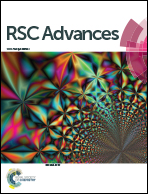Hemoglobin detection using curcumin nanoparticles as a colorimetric chemosensor
Abstract
This article presents a simple and efficient measurement system for quantitative sensing of blood hemoglobin (Hgb) using curcumin nanoparticles (CURNs). The Hgb monitoring is based on CURNs aggregation in the presence of Hgb, which leads to a decrease in the absorption intensity of CURNs. In this study the analytical signal for the measurement of blood Hgb concentration was defined as the difference in absorption intensity of the CURNs in the absence and presence of Hgb. The method was optimized to enhance the selectivity and sensitivity of the method by investigating the effect of variables such as pH of the sample solution, buffer concentration, required amount of CURNs, equilibrium time and tolerance limit of various probable interferences. Under optimum conditions, the difference in absorption intensity of the CURNs was linearly proportional to the concentration of Hgb in two ranges 1–40 μg mL−1 and 150–1200 μg mL−1 with a detection limit of 0.1 μg mL−1. The relative standard deviation for ten replicate measurements of 20 μg mL−1 and 600 μg mL−1 of Hgb was 3.6% and 3.1% respectively. The sensing method was successfully applied for the measurement of Hgb in human blood with satisfactory results.


 Please wait while we load your content...
Please wait while we load your content...